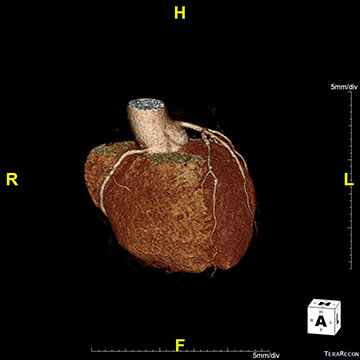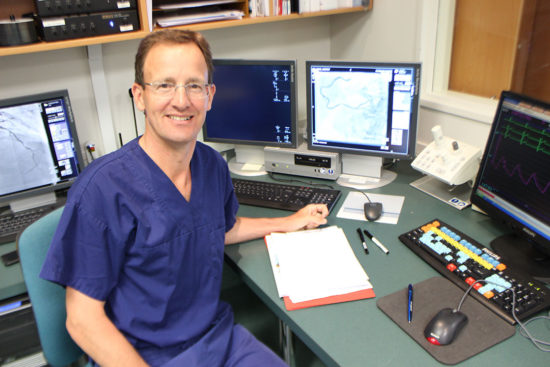What Is My Heart Risk?
 At Cardiology Specialists we can help work out your heart risk.
At Cardiology Specialists we can help work out your heart risk.
Risk factors for heart disease are… family history of heart attacks, stents or heart surgery; high cholesterol; high blood pressure; diabetes; and smoking.
Patients may only need One risk factor.
Despite exercising and having a healthy diet, patients can still develop heart disease due to a family history of heart disease. Sometimes the genes for heart disease can skip a generation. Patients who had a parent or sibling who died suddenly at a young age from a heart attack are at higher risk.
Investigations:
Resting Electrocardiograph (ECG)
A Resting ECG at Cardiology Specialists is an electrical tracing of your heart. Electrodes are placed on the skin of your arms, legs and across chest to measure electrical activity of the heart. It gives information about heart rate, evidence of old heart attacks, thickening of heart muscle, or heartbeat problems such as extra (ectopic) beats or atrial fibrillation.
Exercise ECG Test (ETT)
Exercise test at Cardiology Specialists is used to assess the effect of exercise on symptoms, heart rhythm and ECG changes. Exercise increases the workload of the heart resulting in an increased heart rate and increased blood flow to the heart muscle. The heart ECG tracing and blood pressure are monitored as the patient walks or jogs on a treadmill to assess whether symptoms and/or changes in the resting ECG tracing occur with exercise. ECG changes with exercise may suggest narrowings or blockages in coronary artery(s) supplying the heart muscle. It is also useful for assessing certain levels of fitness. You can stop the test at any time. The ETT is performed by a trained technician and supervised by a doctor.
Echocardiography
Echo at Cardiology Specialists uses ultrasound to measure function of heart chambers and heart valves. Echo is also called Cardiac Ultrasound, which uses high frequency sound waves and is similar to a gall bladder or pregnancy ultrasound but is instead focused on the heart. Professor Hamid Ikram pioneered the introduction of Echo to Canterbury. At Cardiology Specialists, Echo is performed by a specially trained technician who moves a plastic transducer on the skin of the chest wall to obtain pictures of the heart chambers and valves. Echo (cardiac ultrasound) is useful for diagnosing weakened heart muscle, old heart attacks, heart valve narrowing or leaking, thickening of heart muscle, holes between heart chambers, or fluid in the sack around the heart.
Depending on the results of these tests you may go on to have imaging of the coronary arteries.
CT Coronary Angiography
 CT coronary angiography arranged at Cardiology Specialists is where you sit inside a CT scanner and contrast is injected through a vein in the arm while you hold your breath. The CT scanner takes pictures of the heart arteries and then special software processes the images in time with your heart beat. The CT images can help rule out coronary disease, or show the extent of early cholesterol deposits (plaque) within the coronary arteries. Sometimes it can reveal more severe coronary narrowings. It is important that your heart rate is regular and slow to get good images. The presence of too much calcium or heart movement artifact can affect the image quality. This test is useful if the pain is atypical, you are at low to intermediate risk, and/or the exercise test is inconclusive. There is a small risk of radiation and allergy to contrast.
CT coronary angiography arranged at Cardiology Specialists is where you sit inside a CT scanner and contrast is injected through a vein in the arm while you hold your breath. The CT scanner takes pictures of the heart arteries and then special software processes the images in time with your heart beat. The CT images can help rule out coronary disease, or show the extent of early cholesterol deposits (plaque) within the coronary arteries. Sometimes it can reveal more severe coronary narrowings. It is important that your heart rate is regular and slow to get good images. The presence of too much calcium or heart movement artifact can affect the image quality. This test is useful if the pain is atypical, you are at low to intermediate risk, and/or the exercise test is inconclusive. There is a small risk of radiation and allergy to contrast.
Dr Dougal McClean is an affiliated provider for Southern Cross for CT coronary angiogram.
Coronary Angiography
 Coronary Angiography arranged at Cardiology Specialists is performed when you have symptoms which are suggestive of angina, and/or the exercise stress test is positive. A coronary angiogram is the gold standard in deciding whether you need treatment of heart blockages. In many cases, a stent can be inserted at the same time as the coronary angiogram if a severe coronary narrowing is found, see: Stents.
Coronary Angiography arranged at Cardiology Specialists is performed when you have symptoms which are suggestive of angina, and/or the exercise stress test is positive. A coronary angiogram is the gold standard in deciding whether you need treatment of heart blockages. In many cases, a stent can be inserted at the same time as the coronary angiogram if a severe coronary narrowing is found, see: Stents.
Dr Dougal McClean will explain the benefits and risks of the procedure and you will give informed consent. You will be given some medication to relax you. Local anaesthetic is used to numb an area of skin in the forearm just above your wrist. A small tube is placed into an artery in the forearm and catheters are advanced through the blood vessels to the heart. Dye is then injected so that the blood vessels around the heart muscle can be seen on X-ray. Pictures of the heart arteries in different projections are then obtained giving Dr McClean information about the state of your heart and the exact nature of any narrowed blood vessels. In many cases, Dr Dougal McClean can insert a Stent at the same time as the Coronary Angiogram if a severe coronary narrowing is found, see: Stents.
